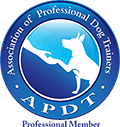Archived OLDT :: Building Relationship
Our dogs have become full-fledged members of our families, snuggling in our beds and accompanying us on our vacations. Just like our human family members, we expect love and respect from our dogs, not rude, demanding behavior. Here are some basic behaviors that we can teach our dogs that will assure politeness:
"Say Please!": Sit
We teach our children to say "please" and yet we don't seem to mind our dogs nudging us with their noses for a bit of attention. Furthermore, what we don't foresee is that what may start as a gentle nudge may well develop into more demanding behaviors.
Consider a sit to be your dog's way of saying "please." When approaching him in his crate, wait for him to sit before letting him out. When delivering a treat, a sit would be nice. Before inviting him onto the couch... yup, you guessed it!... wait for a sit. Before you know it, he'll be offering this behavior with greater frequency. And it's a great alternative behavior to the pushier ones like jumping up and demand barking.
Impulse Control: Wait
A great many dogs have the tendency to jump up on people during greeting. They rush through doors ahead of us and shove their noses in their bowls before they've even made it to the floor. How pushy is that!
Teach your dog patience. Have him remain seated when visitors approach. Make him wait at the door or wait as his bowl is lowered to the floor, then release him. Think of the many occasions you might use a wait with your dog, when crossing the street, when putting on his leash... the possibilities are limitless!
Recall: Come
Recall is not only inspired by a highly prized reward, such as wonderful treats or a fun game of tug, but also by a genuine desire to be with his human partner. That said, there is no greater measure of the depth of a relationship than the strength of your dog's recall.
Puppies come with a pre-installed recall. Make sweet, happy repetitive noises and a puppy will trot right over, ready to join in the fun. Unfortunately, we often ruin this natural recall by calling the puppy over for something unpleasant, like putting his leash on to leave the dog park, getting out the nail clippers, or reprimanding him for a misbehavior. Assure your puppy's continued responsiveness by always rewarding him with something pleasurable, like a treat or a toy or simply a little bit of love.
Keep in mind that not everything that your puppy likes is reinforcing 100% of the time. If it's dinnertime and he's hungry, then food will be a welcome reward, lovin' won't be. Similarly, if he's just had his dinner, he's quite likely not hungry any more, so a fun game of tug may be more enticing than a treat.
Sharing Quiet Time: Down-Stay
I share my life with a German Shepherd Dog named Trista. From the start of our life together, I taught her to hold a good down-stay. These days, I take Trista everywhere with me, on trips across the country involving boat ferries, horse-drawn carriages, motels and shops that allow dogs and, of course, sidewalk cafes. She can go so many places with me because she is a pleasure to be with and around: She lies quietly beside me, bothers no one by soliciting attention or making noise, tolerates the unexpected with grace, and seems happy just to be included. And our relationship is deepened precisely because we can share so much together.
Holding Hands: Loose-Leash Walking
One of the most insidious problems, and one of the hardest behaviors to resolve, is pulling on leash. There are some very effective tools out there to alleviate the problem, walking equipment such as the Easy Walk harness and the Gentle Leader headcollar. Still, these are only management tools and will not teach your dog to loose-leash walk.
Regard loose-leash walking to be like holding hands with a loved one; neither partner is tugging or pulling on the other. Further, consider that a dog walking on a loose leash must be constantly attentive to the whereabouts of his human, often checking in with the flick of his ears or a glance. A dog at the end of a taut leash needn't expend any peripheral attention on his human partner, as he can feel his human quite palpably at the end of the leash.
Clearly, there is more relationship, attention and respect between the partners accompanying each other with a loose leash. Training this behavior is definitely worth the effort!
Dogs With Jobs
Nowadays it's rare that we ask our house dogs to do the work for which they were intended, even as those traits still surface, often to our dismay. The trick is to tap into those natural traits of your dog, channeling them in positive, creative games and tasks, while discouraging some of the more troublesome aspects of their behaviors.
Ultimately, you know your dog and you know his strengths... learn to use them to best advantage, for your dog's well-being as well as your own. For starters, this can be achieved as simply as using puzzle toys for meals and snacks. But there are so many more creative possibilities that can provide mental and physical challenges in your dog's life.
Training article discrimination is a great way to challenge a brainy pooch. Games such as Fetch (particularly of helpful items such as the newspaper or slippers), Hide-and-Seek, and Go Find It! (an exercise in searching out a hidden morsel of food) can be fun activities that burn both mental and physical energy. Saddling your dog up with a doggie backpack can provide a little extra exercise as well as a sense of purpose. Finally, getting involved in dog sports such as agility, sheep herding, tracking and skijoring (in snowy climes) can be wonderful fun for both the canine and human participants.
Note: Always check with your veterinarian first before making drastic changes to your dog's exercise regimen.




